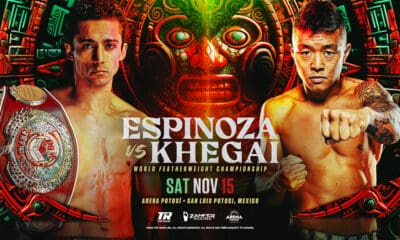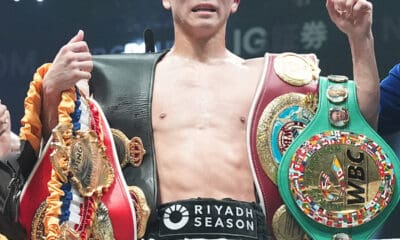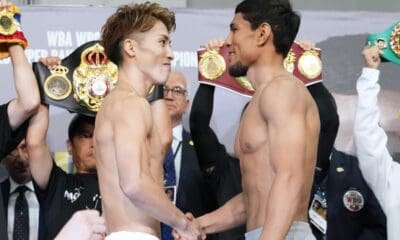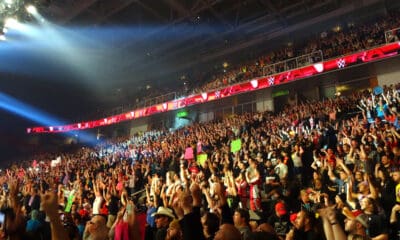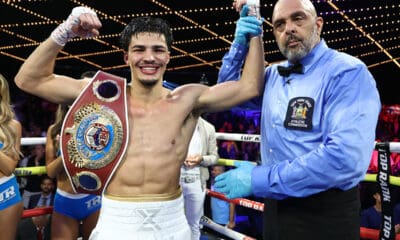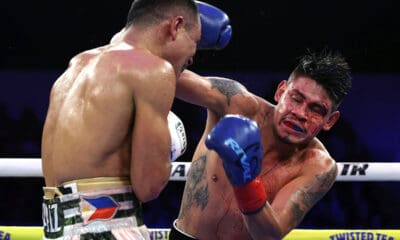The Navarrete vs Valdez fight card main event is almost here. There are moments in sports that produce high-intensity, maximum drama, and unspeakable angst for athletes and fans alike. Every sport has its individual scenarios: hockey has OT shootouts, soccer is at its best when a penalty shootout is needed, and few knives can cut through the tension of a bases-loaded bottom of the 9th scenario with the team down by one and two outs (full count).
Tonight, live from the Desert Diamond Arena in Glendale, AZ, boxing’s most exciting scenario is offered center stage on ESPN/ESPN+ as an all-Mexican showdown takes place between WBO junior lightweight champion Emanuel Navarrete defends his title against former two-division world champion Oscar Valdez.
In boxing lore, the Mexican VS Mexican matchup has produced some of the best fights in its storied history, along with some dramatic outside-the-ring shenanigans, or better said, todos las travesuras. In fact, it was this kind of matchup that created the love language I have for boxing. The culmination of my entire fascination with this sport stems from the fights between the likes of Ruben Olivarez and Chucho Castillo.
Of course, the last of their three fights took place in 1971, about 15 years before I was born. So, I guess Marcos Antonio Barrera-Erik Moralez would be the Big Bang to my boxing universe.

Navarrete vs Valdez Fight Card Promises Superior Drama
Navarrete and Valdez have produced exciting fights and their styles offer a great deal of potential by way of a fight-of-the-year contender. But to suggest that all Mexican fighters do is bang it out would be inaccurate because when you look at these fighters you notice that their styles are eclectic.
So, how is it that Mexican fighters seem to produce similar fights in the way of excitement when the actual fighting styles come in many styles?
Perhaps it is the ancientness of the Aztec, Toltec, and Myan warrior DNA surging through the blood and into the very heart of today’s Mexican combatants.
Or maybe it is the harsh conditions and rough upbringings that come from being poor and void of options in “modern” Mexico that keep these fighters going because deciding to stick it out for 10-12 rounds seems easier when compared to border crossings, cartel-controlled areas filled with violence, and corrupt government officials who sellout the people in the villages that they’re meant to protect and help flourish.
Whatever the reason, and it may be all of them, these types of matchups produce fireworks, and in a situation where you get paid to get into the ring (not for winning), there has to be some sense of pride or honor in a Mexican defeating another member of the tribe in a (sometimes) friendly contest.
While NYFights.com will keep you updated on this evening’s fight, I will provide you with some context from the past by delivering three of the most impactful Mexican VS Mexican fights in boxing history.
3. RAFAEL MARQUEZ vs ISRAEL VAZQUEZ (tied 2-2 in four fights spanning 2007-2010):
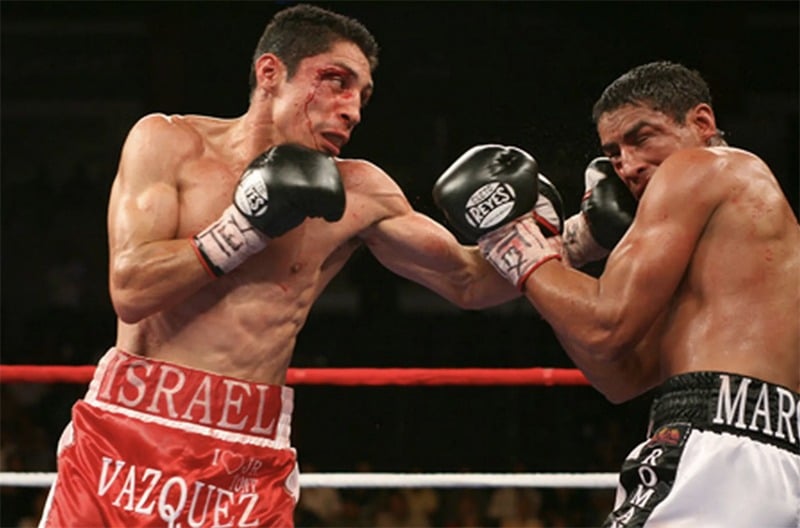
Israel Vazquez (left) and Rafael Marquez tangled in four memorable bouts.
This is a complex addition to this list because while there was something violently artistic about their first 3 fights at 122lbs, the fourth fight is an example of the capitalist greed that sometimes infects the purest aspects of this sport. Both men seemed like they fit together like a bloody puzzle piece—an absolute no-brainer for matchmakers.
Like Valdez and Navarrete, both Vazquez and Marquez went into the first bout with high expectations for action and they, too, evoked the historical significance of all-Mexican showdowns in the media leading up the fight.
Despite Vazquez scoring a knockdown in the 1st round, it was Marquez who stole more moments in the fight with his heavy punching combination and hand speed. Marquez would take the first fight after Vazquez retired on his stool after seven grueling rounds, although he was heard saying he’d had enough two rounds before the fight was called off.
The second fight was even better than the first and won “Fight of the Year” by several outlets, including RING Magazine. Marquez was cut in the 3rd, but Vazquez’s eyes, which were starting to build up a significant amount of scar tissue by that point in his career, were also opened up.
After being floored in the 6th, Marquez would get to his feet before the ref’s 10-count. However, Vazquez swarmed him off the break and referee Jose Guadalupe Garcia would wave off the fight, thus making it 1-1. Both fighters were adamant that there would be a 3rd fight immediately following post-fight interviews.
The 3rd fight took place at the scene of the first, Carson, California, sparking an era of incredible fights at the Home Depot Center. This fight produced one of the best rounds of the rivalry—a round 4 that saw Marquez knockdown Vazquez who got off the canvas to take control of the round and switch momentum (voted “Round of the Year” by RING Magazine).
This fight was an evenly fought fight and the only one of the four to go the distance. In the end, Vazquez would take home a split-decision victory with scores of 114-111, 113-112, and 111-114.
It would be over a year before eighter fighters fought again, and the finale of their epic would take place two years after their 3rd contest. By this time, Vazquez’s orbital bone had multiple surgeries, and the area around his eye socket was cut with a hard gust of wind. Despite his toughness, Vazquez should have called it a career.
Marquez dominated the fourth fight and it ended the way MANY boxing pundits predicted—with a ref stoppage due to cuts over Vazquez’s eye. The 4th fight was worth big money, but the finances suggested there was more juice to squeeze. Fortunately, Vazquez’s handler, Frank Espinoza, would attempt to convince his fighter to call it a career.
Vazquez fought once more before retiring, but Marquez went on to fight for several more years, losing 4 of his next 6 fights following his final fight with Vazquez.
2. CARLOS ZARATE vs ALFONSO ZAMORA (Zarate won by TKO in the 4th):
This was a blood feud at its finest. Zarate and Zamora were former stablemates and their rivalry had hit new heights by the time they were scheduled to fight in April of 1977 at The Forum in Inglewood, California.
The fight started with a fan running into the ring, drunk, attempting to fight one of the combatants. However, because of the fierce rivalry between the “Z-boys,” extra precautions were taken, and a riot squad was in attendance. The drunk fan was quickly taken care of at the hands of the police.
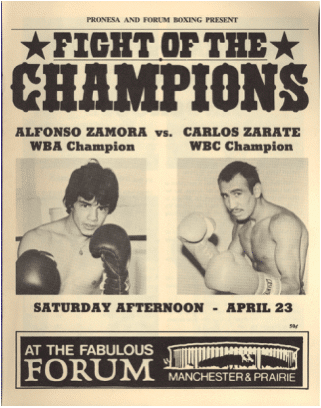
Zamora took control of the fight in round 1 following the fan interference, but Zarate would come back to score a knockdown in round 3 after nearly 5 minutes of back-and-forth action spread out through rounds two and three.
In the end, it appeared as though Zamora had left his best effort in the first quarter of the fight, and Zarate took full advantage by dropping the WBA bantamweight champ twice in round four. Zamora’s trainer/father would throw in the towel shortly after referee Richard Steele waved off the fight.
The action was far from over, however, as Alfonso Zamora Sr. walked straight into the ring and towards Arturo Hernandez (Zarate’s trainer, and formerly Zamora’s). Both camps erupted into a brawl and once again the riot squad was made necessary.
Navarrete vs Valdez Fight Card Won’t Top Barrera vs Morales 1!
1. Marcos Antonio Barrera VS Erik Morales Trilogy (Barrera would take the series 2-1, spanning 200-2004):
This is the marquee matchup in the history of Mexico VS Mexico. The pinnacle of great fights was founded on a real blood feud between two men from rivaling hometowns of Tijuana (Morales) and Barrera (Mexico City)—a feud that exists today.
The rivalry produced excellent action inside the ring which was amplified by their apparent hatred for one another, evident by Barrera punching Morales at one of their press conferences, a scene that’s embedded within boxing’s zeitgeist.
The first matchup took place at the Mandalay Bay Resort and Casino, in Las Vegas and was broadcast on HBO.
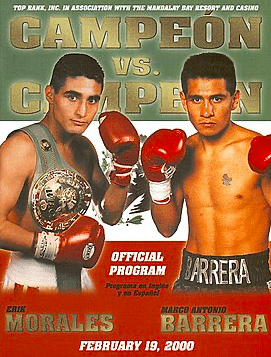
Morales took the first fight against Barrera at junior featherweight in a fight that was named “Fight of the Year” by RING Magazine and even took home honors as “the greatest fight of all-time” by several outlets.
While the fight was tremendous, there were those that believed Barrera deserved the victory, but the scores were razor close—114-113 for each fighter with judge Dalby Shirley’s 115-112 score in favor of Morales.
The second fight took place in June of 2002 and is credited as more of a chess match than the first contest. Barrera brought a technical approach to the ring with Morales whose strategy appeared to be reliant on heavier punches.
Barrera would take the second fight by way of unanimous decision—scores of 115-113 twice and 116-112—and, like the first fight, many believed the wrong man won the decision.
Fans and media felt like Morales did enough to earn the decision, but he was hampered by a body-shot knockdown on Barrera that referee Jay Nady ruled a slip.
With the first fight taking place at junior featherweight, and the rematch at featherweight, it made sense that the finale take place at super featherweight/junior lightweight.
By the 3rd fight, Barrera had lost his world title status in a 2003 bout with Manny Pacquiao in San Antonio. Morales, on the other hand, picked up a super featherweight world title by defeating Jesus Chavez.
Barrera won a majority decision by scores of 115-113, 115-114, and 114-114 in a November 2004 trilogy bout that once again earned “Fight of the Year” honors in front of fans at the MGM Grand in Las Vegas.
Both fighters would become friends (or at least friendlier) after their rivalry and they speak fondly of one another today.
















